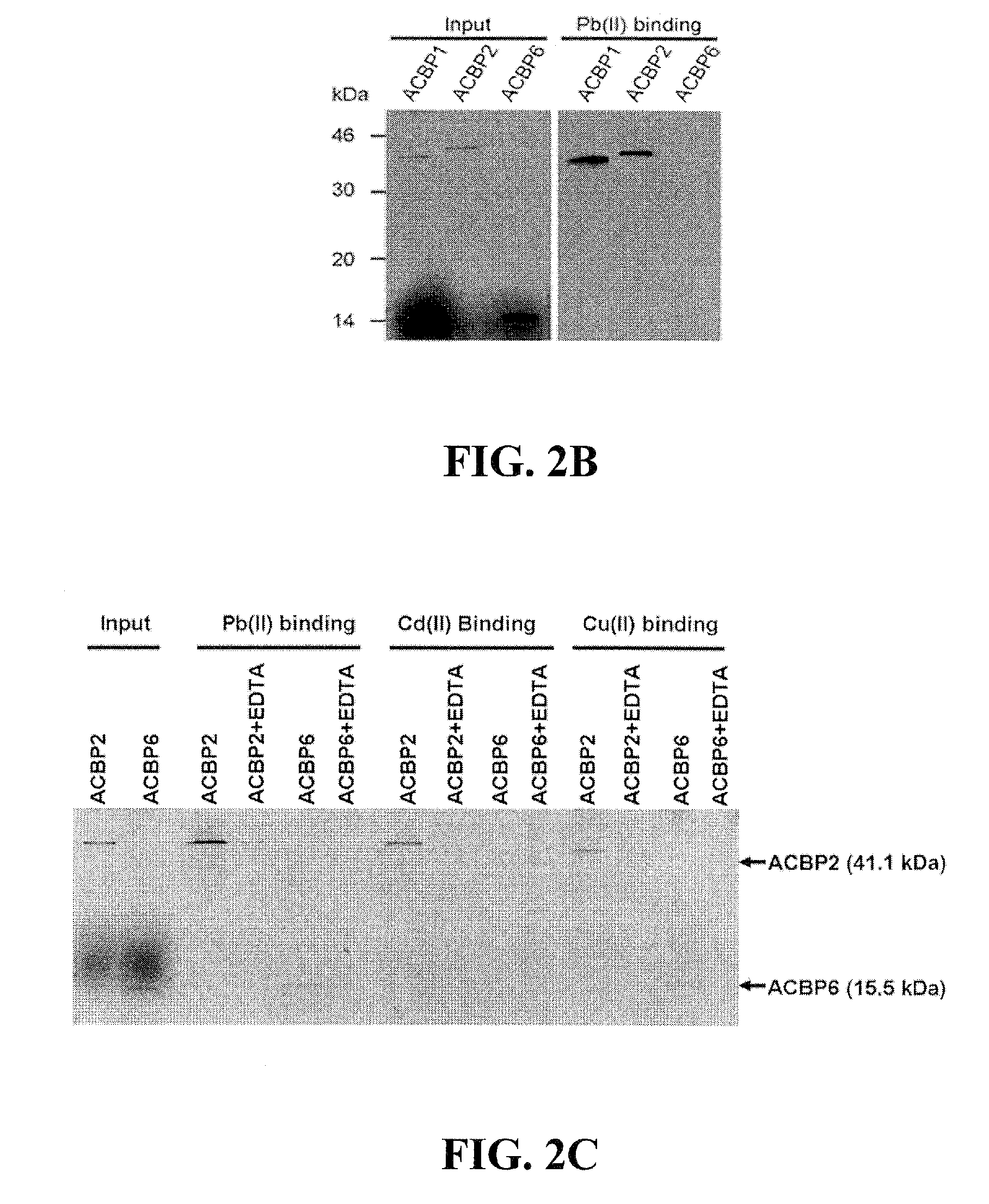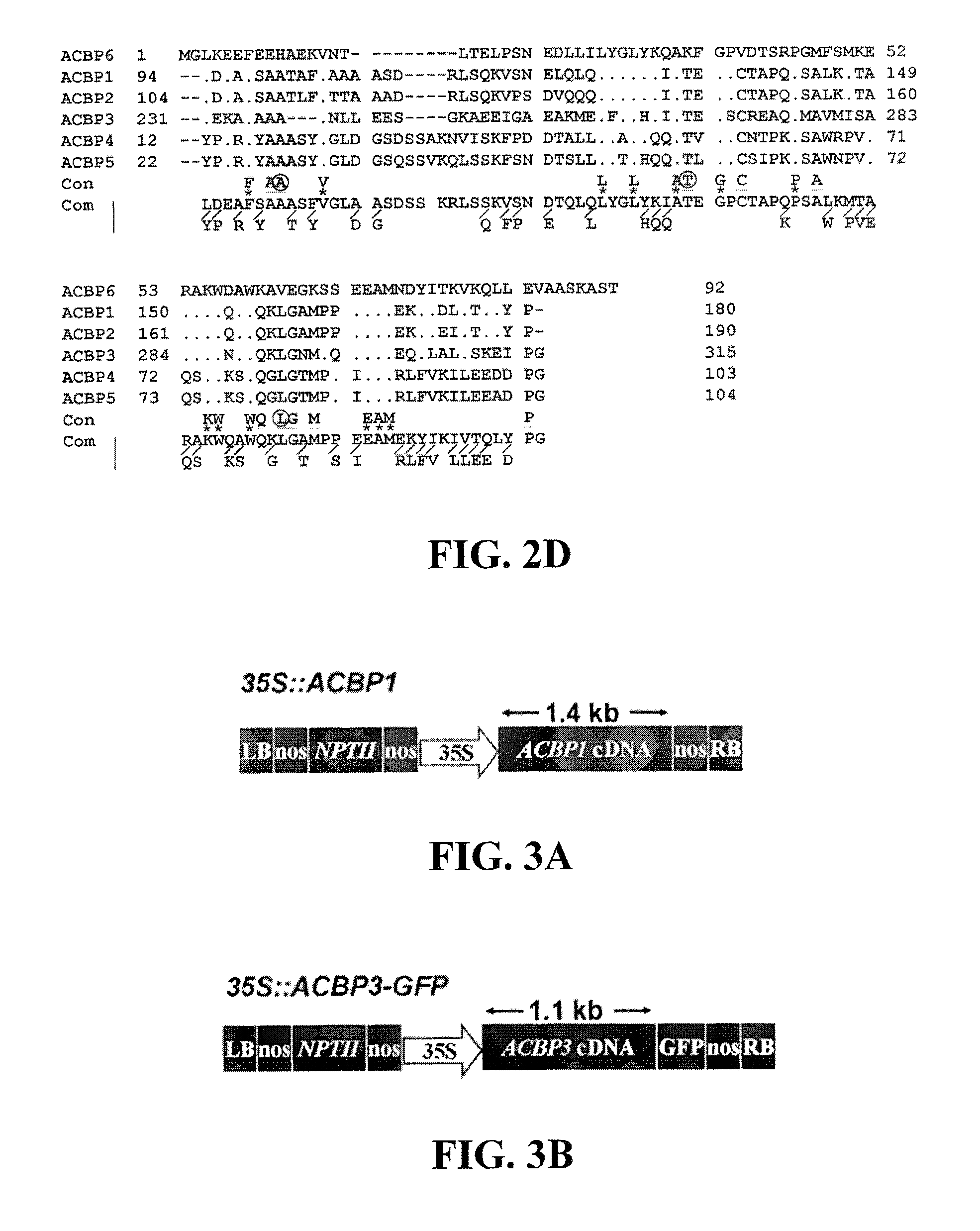Methods of using transformed plants expressing plant-derived acyl-coenzyme-A-binding proteins in phytoremediation
a technology of acyl-coenzyme-a-binding proteins and phytoremediation, which is applied in the field of bioremediation, can solve the problems of contaminated soil reclamation, adversely affecting the human nervous system, causing cancer, and lack of plant genes capable of binding proteins
- Summary
- Abstract
- Description
- Claims
- Application Information
AI Technical Summary
Benefits of technology
Problems solved by technology
Method used
Image
Examples
example 1
Plant Materials, Growth Conditions and Treatment
[0079]Arabidopsis thaliana wild-type Columbia (ecotype Col-0), ACBP1- and ACBP3-overexpressing transgenic plants (ecotype Col-0) were grown under 8 h dark at 21° C. and 16 h light at 23° C. cycles. For Pb(II)-inducible gene expression analysis, Arabidopsis seedlings were grown for 3 weeks in continuous light, treated with 1 mM Pb(NO3)2 or water (as control), and shoot and root samples were collected at 24 h post-treatment. For Pb(II) sensitivity tests, Arabidopsis seedlings were surface-sterilized and grown on Murashige and Skoog (Physiol. Plant. 15: 473-497, 1962) medium containing 2% sucrose with or without 0.75 mM Pb(NO3)2 (Sigma-Aldrich, St. Louis) for 2 to 3 weeks.
example 2
ACBP Transcripts are Induced by Pb(II) Treatment
[0080]To determine if the regulation of Arabidopsis ACBP mRNAs responds to Pb(II) stress, we performed reverse transcription-PCR(RT-PCR) using root tissue RNA following treatment with 1 mM Pb(NO3)2. For RT-PCR, total RNA was extracted with TRIzol (Invitrogen) reagent, according to the manufacturer's protocol, from roots of 3-week-old wild-type Arabidopsis (Col-0) seedlings in the presence or absence (water as control) of 1 mM Pb(NO3)2. RT-PCR analysis was performed as according to the manufacturer (Invitrogen Cat No. 12371-019). Specific primers were designed based on mRNA sequences. Primers used for RT-PCR analysis of ACBP6 were ML750 (SEQ TD NO:1) and ML751 (SEQ ID NO:2); ACBP1, ML179 (SEQ ID NO:3) and ML759 (SEQ ID NO:4); ACBP2, ML194 (SEQ ID NO:5) and ML205 (SEQ ID NO:6); ACBP3, ML783 (SEQ ID NO:7) and ML784 (SEQ ID NO:8); ACBP4, ML849 (SEQ ID NO:9) and ML850 (SEQ ID NO:10); ACBP5, ML352 (SEQ ID NO:11) and ML353 (SEQ ID NO:12); 18S...
example 3
Expression of Recombinant ACBPs in E. coli BL21DE3 Cells
[0082]Each of the six cDNAs encoding Arabidopsis ACBPs were cloned in plasmid pRSET (Invitrogen) for expression in Escherichia coli according to protocols specified by Invitrogen, as (His)6-tagged ACBP recombinant proteins that were subsequently used to ascertain if these (His)6-ACBPs bind Pb(II) in vitro. The ACBP-pRSET derivatives were expressed in bacterial (Escherichia coli BL21DE3) cells and subsequently harvested for purification of the (His)6-tagged proteins following methods described in Leung et al. (Planta 223: 871-881, 2006). These purified ACBP recombinant proteins were then tested for the ability to bind lead using Pb(II)-binding assays (Funaba and Mathews, Mol. Endocrinol. 14: 1583-1591, 2000).
[0083]E. coli BL21(DE3)Star pLysS (Invitrogen, Carlsbad, Calif., USA) were transformed with each of the six plasmids expressing recombinant ACBP6 (10-kDa ACBP) and ACBP1 to ACBP5. Transformed cells were grown to OD600nm=0.4,...
PUM
| Property | Measurement | Unit |
|---|---|---|
| molecular mass | aaaaa | aaaaa |
| temperature | aaaaa | aaaaa |
| temperature | aaaaa | aaaaa |
Abstract
Description
Claims
Application Information
 Login to View More
Login to View More - R&D
- Intellectual Property
- Life Sciences
- Materials
- Tech Scout
- Unparalleled Data Quality
- Higher Quality Content
- 60% Fewer Hallucinations
Browse by: Latest US Patents, China's latest patents, Technical Efficacy Thesaurus, Application Domain, Technology Topic, Popular Technical Reports.
© 2025 PatSnap. All rights reserved.Legal|Privacy policy|Modern Slavery Act Transparency Statement|Sitemap|About US| Contact US: help@patsnap.com



